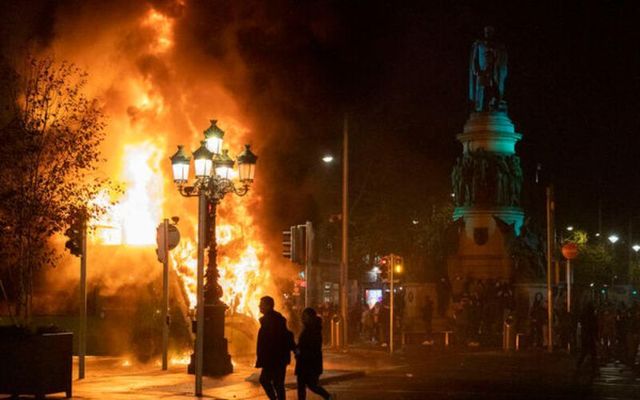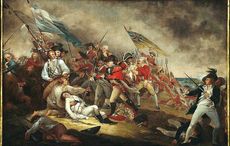Like many, I cried when I learned of the knife attack in Dublin's Parnell Square East on Thursday, 23 November, which left two adults and three children injured.
A childcare worker and one of the three children injured in the attack remain hospitalized, while the attacker is also still in hospital.
On my recent visits to Dublin, on buses and in cafés, I was surprised by the normalization of racist comments.
I also found the city center somewhat scary by night. Last time I stayed in Wynn’s Hotel, on Abbey Street, I noticed that the door was locked by 11 pm and clients had to ring the doorbell for the porter to unlock the historic doors after he scrutinized who wanted to gain access in the glass panes under the entrance’s spectacular stained-glass awning.
The building that had withstood so much over the years seemed once again to be on guard. The inaugural meeting of Cumann na mBan on April 2, 1914 was held there; it was burned to the ground during the 1916 Rising and rebuilt in 1926. It was where Seán Lemass hosted the first Free State lecture on Unemployment in 1936. The renowned hotel was also used as a location for both Neil Jordan’s film “Michael Collins” and Jim Sheridan’s film “The Boxer."
When I stayed there in 2022, Lower Abbey Street, where Wynn’s is located, was eerily empty in the evenings, apart from groups of young lads loitering and fat, brazen seagulls attacking rubbish bags they managed to extract from garbage bins.
However, I was still somewhat surprised when people asked, “Why are you staying in Lower Abbey Street, are you looking to get your throat slit?” As a Northsider, O’Connell Street, Henry Street, Abbey Street, Capel Street, and Parliament Street, were my former stomping grounds, and the city center was my favorite part of Dublin.
However, nothing I witnessed, prepared me for the violent images beamed across the world of Irish far-right agitators rioting, looting, setting Gardaí cars and public buses aflame, and clashing with Gardaí in the aftermath of the Dublin knife attack.
The Dublin riot did not go unnoticed abroad. Here in France, Reuters reported on 29 November: "The Dublin riots on Nov. 23, led by far-right groups after three children were stabbed in the capital, were a 'trigger' for such a strong reaction in France over the last few days. A French intelligence source told Reuters that there was a will among French far-right activists to be "as good as the Irish.”
Elsewhere, American white nationalist Nick Fuentes claimed during his 27 November show on Rumble that "Ireland is on the brink of civil war,” adding “It’s going to be ugly.”
Right-wing US commentators continue to stoke the fire, with shocking editorial lines - Tucker Carlson said "the Irish government is trying to replace the population of Ireland with people from the third world" while Steve Bannon claimed Ireland is a "powder keg."
However, not only foreign voices reported inaccurately in the heat of the moment. Irish artist Adam Doyle wrote in The Irish Times: “What happened in Dublin on Thursday night was terrible, but should come as no surprise. This is the result of simmering tensions in the north inner city finally hitting boiling point.”
Many people residing in the north inner city are victims of poverty and the disastrous housing crisis. However, circumstances have not transformed them, apart from the few, into right-ring agitators.
Fintan O’Toole, eminent Irish Times editorialist, retorted: “The addresses of those charged include a few in inner Dublin but also in Rathmines, Tallaght, Dún Laoghaire, Celbridge, Swords and towns as far away as Bray, Navan, Longford and even Waterford.
"It’s grossly unfair to inner city communities to stigmatise them as the sources of this disgrace."
Taoiseach Leo Varadkar stated that the rioters in Dublin brought “shame on Ireland.” The Irish far-right agitators and their copiers, of course, failed to acknowledge that the two biggest heroes of the day were foreigners, Caio Benicio, a Brazilian food delivery driver who stopped the knifeman with his helmet, and Alan Loren-Guille, a trainee chef from France who aided him in disarming the attacker. It certainly was not far-right neo-fascists who jumped into the ring to save the 23 November victims.
However, it seems far-right agitators, in both Ireland and France, creep out of their bunkers in the aftermath of heinous crimes, using them as leverage to construct cenotaphs of hatred against immigrants. Just this past Sat, 2 December, there was a horrific terrorist attack in Paris. The attacker, Armand R, a 26-year-old French national, was born in France to Iranian parents. He stabbed to death a German tourist and injured two other people. He was known to French authorities for radical Islamism and mental health troubles and this new tragic event will further fuel the French far-right’s hatred.
The far-right in Ireland has been recorded as existing in various forms and raising its head episodically since the 1930s. The vast majority of Irish people see the several hundred ‘Dublin riot’ far-right agitators and neo-fascist activists for what they are.
However, in France, the following that neo-fascist activist Jean-Marie Le Pen attracted 50 years ago has evolved into including sleeker, more sophisticated adherents with 28-year-old Jordan Bardella, of JFK-type good looks, the current president of the National Rally, (FKA the National Front founded by Jean-Marie Le Pen in 1972) and with Marine Le Pen also at the helm. Seeing Bardella, Marine Le Pen, and their cohorts in a perfect line, with their scintillating silk Republican sashes on 12 November in Paris, in the over 100,000 cortege that turned out to march against anti-Semitism, was surreal, taking into consideration the original and genetic strong element of neo-Nazism and Holocaust denial in the National Front. Many, including myself, are worried and hope France’s motto of ‘liberty equality fraternity’ will withstand the 2027 elections, and the tsunami of populism submerging much of the world.
As for Ireland, Seán Lemass, widely regarded as the father of modern Ireland, might also worry as he looks down on the country he did so much to build, wondering how riots in Dublin’s city center became an inspiration for far-right gurriers the world over.
This article was submitted to the IrishCentral contributors network by a member of the global Irish community. To become an IrishCentral contributor click here.




Comments